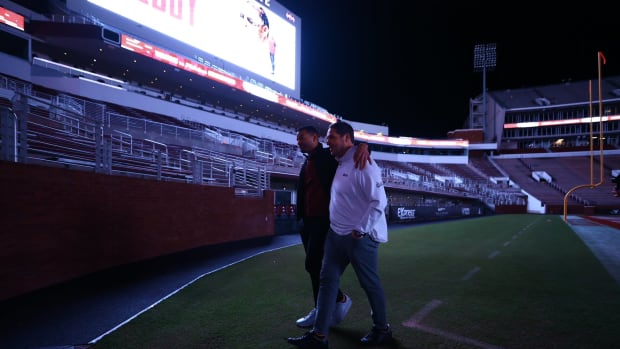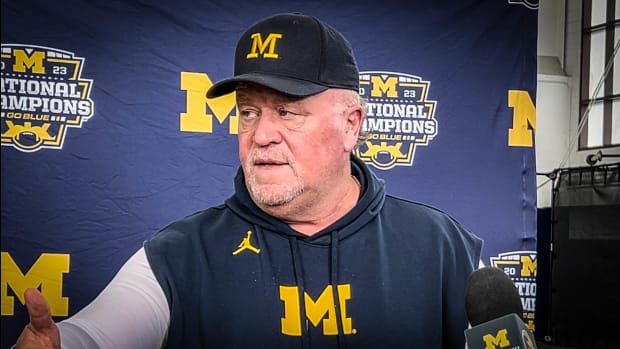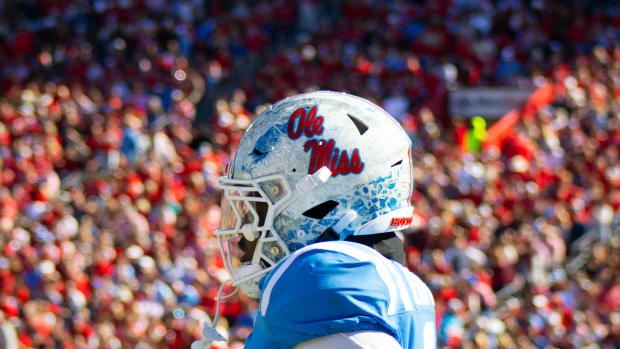Can Kansas's Nightmare Scholarship Situation Convince Anyone to Change the Rules of Recruiting?
Kansas athletic director Jeff Long, a relative newcomer to the Big 12, stood before his fellow athletic directors last week in Scottsdale, Ariz., and asked them to consider a proposal that would help Long’s football team and none of theirs. The question now is whether any of those other ADs will realize that one or several of their teams might need what Long suggests someday.
Long knew he’d get a chilly reception, but he made the ask anyway. His football program has been gutted. The first mistake was hiring Charlie Weis, who put Kansas in a deep scholarship hole by signing a bunch of junior college players who didn’t pan out. It was so bad that after the first spring practice under Weis’s successor David Beaty, the Jayhawks had only 28 scholarship players. Beaty initially tried to build the time-tested way—with high school recruits who would spend between three and five years in the program—but as the losses mounted, he felt the pressure to improve immediately and also began looking for quick fixes from the juco ranks. In Beaty’s final two recruiting classes, 24 of 46 signees came from junior colleges. Sheahon Zenger, the AD who hired Weis and Beaty, was fired last year. In came Long, who fired Beaty and hired Les Miles. The 67-year-old Miles seems excited about the job, but Long estimates it will be four years before the Jayhawks play with a roster anywhere the NCAA maximum of 85 scholarships.
So Long asked his fellow ADs to consider the idea of tweaking recruiting rules to allow a team in a scholarship hole to climb out and get competitive more quickly. How would this work? We’ll start with a vocabulary lesson. In NCAA parlance, an initial counter is a new scholarship player. This can be a signee from high school, a junior college transfer or a transfer from another four-year school. There has been a lot of arguing over the years about initial counters. How many can a program sign in each signing period? How many can a program bring in during each school year?
The answer to that last question in football at the moment is no more than 25. But programs that bring in 25 new players in one year typically can’t bring in another 25 the following year. Everyone has some natural attrition due to players retiring, flunking out or getting booted, which is why most programs don’t operate at exactly 85 scholarships. But combine a massive scholarship deficit with natural attrition and it makes it nearly impossible to field a competitive team.
Long would like programs to have the ability to sign a rolling total of 50 initial counters over two years. He can live with a one-year cap of 35 or so, but he’d like the ability to replenish a roster that has been depleted not because of NCAA sanctions but because of mismanagement by people who don’t work at a place anymore. (Obviously, schools that lose scholarships because of sanctions would not be able to benefit from any changes.) An infusion of 35 (mostly high school) recruits would allow a program to finally redshirt some players. It would help build some depth. Recruit well for two or three cycles and a program could go from a joke to respectability.
When Long brought up the idea last week, he got peppered with objections by his fellow ADs. And because he was the AD at Arkansas during the Oversigning Wars at the end of the previous decade, he understands all of those objections.
If the Big 12 proposed this rule and the rest of the FBS adopted it, here is what the other ADs worry would happen:
• The best programs (at schools without super-strict admissions policies) would horde recruits and then “process” the players who aren’t good enough. This is why the SEC changed its rules a decade ago and the NCAA adopted those changes nationwide. Houston Nutt signed 38 players one year at Ole Miss and said he would have signed more. Nick Saban brought in 56 players in the recruiting classes of 2008 and 2009. Some of those players—the ones who didn’t get processed—took part in three national title runs.
• Newly hired coaches who want to run off the existing players will have an easier time cleansing the roster. The deterrent of having no scholarships available to replace the players who were run off would be gone.
• The ADs also wondered why an affected school couldn’t simply give the available scholarships to walk-ons.
These are legitimate concerns, but it’s important to remember that something just happened to change the dynamics around these issues. The NCAA just stripped schools of the ability to block athletes from transferring to another school on scholarship. We call this The Transfer Portal, which sounds like something out of Star Trek but really is just a big online spreadsheet of which players are interested in transferring.
Even if the 25 initial counter cap—which will keep some players from transferring because potential destination schools have no spots remaining—remains in place, this freedom of movement is going to create more situations like the one at Kansas. A coach losing his grip on a program will lose players as well as games. That coach will get fired, and the next coach will start in a hole. Shouldn’t the players who chose to remain get a chance to be part of a competitive program? On the flip side, if a player feels unwanted by a new coach, he now has the ability to transfer easily, and the NCAA’s “run-off” rule makes it easier than ever to play without sitting out a year.
Long’s best bet is to push this as a player safety issue. A team playing with 50 recruited scholarship players will have to play players more snaps in practices and games. Those players will get hurt, forcing the remaining players to carry even more of the load. Players who should get redshirted will be thrust into games when they aren’t ready. This creates a vicious cycle that will keep a team down for years.
As for the walk-on argument, I’m happy to take that one. In 1996, I walked on at Florida as a 17-year-old, 238-pound offensive lineman. That version of me probably would have been seriously injured had I been forced to play right away. (And the team would have stuuuuuuuuuuuuuuuuuunk if it had needed me on the field.)
Beaty also tried to combat the scholarship crunch by blueshirting players. That practice takes advantage of an NCAA rule designed to allow programs to give a scholarship to an excellent player who happens to show up and enroll. That’s not how it works in practice, though. When schools use the blueshirt rule, they simply don’t bring a player in for an official visit and don’t do an in-home visit. New West Virginia coach Neal Brown used this rule to help climb out of a scholarship hole while working at Troy. But that’s easier when a school sits within driving distance of all the players it recruits, as Troy does. Kansas is not one of those schools. The players who would be willing to forego an official visit that requires a flight typically aren’t as good as the ones who would demand one.
Long also made a practical argument to his Big 12 brethren. If Kansas continues to be a laughingstock, it doesn’t help the Big 12’s best teams when they’re being considered by the College Football Playoff selection committee. Long, a former chair of the selection committee, knows how the committee considers a win against Kansas. It’s not that different from a win against a Conference USA or MAC school. That’s not ideal for anyone. Long knows that some relief isn’t going to turn Kansas into a juggernaut that beats Oklahoma every year. But he’d like to have a competitive team, and he believes a competitive Kansas would be good for the Big 12.
What’s interesting about this is that this could happen to the schools at the bottom of any Power 5 league. Long is trying to help himself, but how many ADs across the country will look at their own programs and wonder if they might someday wind up in the same boat? And if they did, would they want a ladder to help climb out of the hole?
A Random Ranking
We took the kids to Universal Studios this weekend, and they had a lot of questions when we got to Toon Lagoon. Who is Beetle Bailey? Who is that viking? Why is that guy making such large sandwiches? I realized that they’ll never know the joy of rifling through the newspaper to find the comics, ignoring Family Circus and Andy Capp and reading all the strips that were actually good. So here are the top 10 newspaper comic strips.
1. The Far Side
2. Calvin and Hobbes
3. Bloom County (and Outland and Opus)
4. Doonesbury
5. The Boondocks
6. Dilbert
7. Mother Goose and Grimm
8. Peanuts
9. Garfield
10. Shoe
Three And Out
1. Top class of 2020 quarterback prospect DJ Uiagalelei committed to Clemson on Sunday. Prior to the commitment, SI’s Ross Dellenger profiled Uiagalelei.
2. Make fun all you want, Harbaugh haters, but the Michigan football team’s annual trips abroad look incredible. They’re fun, but every one so far also has given players a deeper understanding of history. This year’s destination? South Africa. On Sunday, the Wolverines toured Robben Island, the prison where future South African president Nelson Mandela was held for 18 of the 27 years he was imprisoned before the fall of Apartheid.
3. Last week, the NCAA announced that it had rescinded a ban on championship events in states that allow wagering on single athletic events. The reason? Had the rule stayed in place, the NCAA quickly would have run out of eligible states. Indiana, where NCAA is headquartered, could legalize sports wagering as soon as this week.
What does this mean for college football? Nothing officially. But now that Las Vegas can host NCAA tournament events and the Final Four, it seems logical that a College Football Playoff national title game would go to Vegas. The sites are booked for the next five seasons (New Orleans, South Florida, Indianapolis, Los Angeles, Houston), but don’t be shocked if the new Raiders stadium hosts the title game following the 2024 season.
What’s Eating Andy?
Jon Stark always struck me as a soy milk latte kind of guy.
What’s Andy Eating?
I originally had no plan to try Starlite Bar+BBQ. It’s a barbecue place in a strip mall in Scottsdale, Ariz., and any place in non-barbecue territory* that claims to serve barbecue must be approached with extreme suspicion. Then I read something Starlite co-owner Walter Sterling—who also serves as the executive chef at Ocotillo in Phoenix—said about Starlite. “If you want Texas barbecue, go to Texas,” Sterling told the Phoenix New Times last year. “We’re not trying to be in Texas. We’re in a strip mall in Scottsdale.”
*There is elite barbecue that does check all the boxes in metro Phoenix. It’s at Little Miss BBQ, which you can read about here.
Self-awareness goes a long way with me. I appreciated the honesty, and a glance at the menu suggested that if I approached the place not as a barbecue joint but simply as a carnivore’s paradise that I’d leave satisfied. It also didn’t hurt that I had stumbled across a photo of the Can Can Pork Steak.
My first thought was “Is that a pie?” Then I looked closer. It’s a giant, thick center cut pork chop surrounded by a massive hunk of pork belly. Wedged between the belly and the chop is a cup of jalapeño chimichurri. Who cared if it met the requirements to be considered barbecue? I needed to eat this.
If you truly want to enjoy your massive platter of pork, get there early. For starters, they can run out. Second, Happy Hour ends at 6 p.m. During Happy Hour, bartender Chris makes a mean Old Fashioned that will run you a mere $7. Unlike me, you’ll probably be ordering your Can Can for two. Though you won’t need one to get full, you may want an appetizer to warm up before the main event. Get the crispy rock shrimp in creamy cheese grits. (Also half price if you show up at Happy Hour.)
Before your glorious board arrives, you’ll be presented with a small skillet of cornbread with a giant pat of butter melting across every square centimeter. You’ll be tempted to eat it all yourself, but beware. You need room for what comes next.
The Can Can is one of those dishes that makes every head turn when it comes out of the kitchen. If you don’t like attention, sit in a corner. Because everyone will want to know what you’ve ordered when that cutting board full of pig lands in front of you. If there are two of you, direct the less adventurous toward the chop in the middle. It’s thick, juicy and smoky. It feels like steak and is only slightly less tender than its beef counterpart. The more dedicated carnivores should start with the belly. As you already know—because the type of person who reads this section is the type of person who eats these things—pork belly is proto-bacon. Curing and smoking turns it into our favorite breakfast treat/burger topping/fashion accessory. This belly isn’t cured, but it is smoked. The result is about three layers of a thicker, juicier, slightly less salty version of bacon. This is buffered by a layer of smoked fat that the person who starts on the chop will hate and the person who starts on the belly will love.
Both of you will adore the chimichurri, which adds about three more layers of flavor to pork that probably needed nothing else. I realize this may sound like odd advice coming from me. At a barbecue joint, I’d tell you to avoid the sauce if the meat is cooked perfectly. But Starlite isn’t a barbecue joint. It’s just a jewel in a strip mall in Scottsdale.





